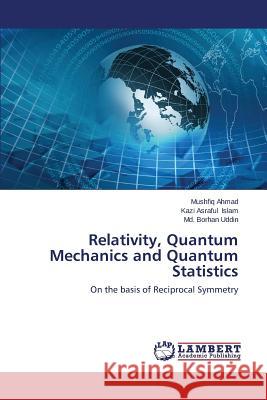Relativity, Quantum Mechanics and Quantum Statistics » książka
Relativity, Quantum Mechanics and Quantum Statistics
ISBN-13: 9783659511202 / Angielski / Miękka / 2014 / 52 str.
To combine the formulas of GR and QM to calculate something, the same answer is always yielded: infinity, still unsolved. The issue of space-time curvature, Problem of quantization, Universe is non-local or local, particles are zero dimensional or what?, Background of space-time and matter, superposition of states and so on are few of unsolved problems of QM and Relativity. We have observed a relation between reciprocity and quantum statistics. Reciprocity may be a bridge between QM and Relativity which is a great unsolved problem. We have defined Reciprocal Symmetry and we have applied it to find an invariant under addition. This invariant quantity is either an upper bound of a set of quantities or a lower bound of the reciprocals of this set. The set bounded above together with this invariant quantity corresponds to Einstein's postulate. we find that discreteness is directly related Einstein's postulate or Lorentz transformation. We have seen that Reciprocals and reciprocal symmetry relate Einstein's postulate and Lorentz transformation to discreteness, wave motion and Fermi-Dirac statistics. Reciprocal symmetry, therefore, relates quantum mechanics (QM) to relativity.
To combine the formulas of GR and QM to calculate something, the same answer is always yielded: infinity, still unsolved. The issue of space-time curvature, Problem of quantization, Universe is non-local or local, particles are zero dimensional or what?, Background of space-time and matter, superposition of states and so on are few of unsolved problems of QM and Relativity. We have observed a relation between reciprocity and quantum statistics. Reciprocity may be a bridge between QM and Relativity which is a great unsolved problem. We have defined Reciprocal Symmetry and we have applied it to find an invariant under addition. This invariant quantity is either an upper bound of a set of quantities or a lower bound of the reciprocals of this set. The set bounded above together with this invariant quantity corresponds to Einsteins postulate. we find that discreteness is directly related Einsteins postulate or Lorentz transformation. We have seen that Reciprocals and reciprocal symmetry relate Einsteins postulate and Lorentz transformation to discreteness, wave motion and Fermi-Dirac statistics. Reciprocal symmetry, therefore, relates quantum mechanics (QM) to relativity.











